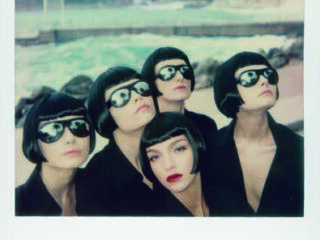
HIP HOP – Living a Dream
through March 1, 2025 // Gallery Bene Taschen
Galerie Bene Taschen is pleased to announce HIP HOP – Living a Dream, an immersive exhibition showcasing the works of renowned photographers Jamel Shabazz (*1960), Joseph Rodriguez (*1951), and Gregory Bojorquez (*1972). From the early 1980s on, each of these three American chroniclers provides distinct insights into the rise and global impact of American hip hop culture. HIP HOP delves into the lifestyle that, in combination with music, graffiti, breakdancing, and fashion, evolved into a worldwide phenomenon – from the streets of 1980s New York to Los Angeles, the Southern United States, Europe, and beyond, persisting into the present day. The exhibition is accompanied by music, interviews, and memorabilia.
Jamel Shabazz’s work from the 1980s serves as both a personal visual diary and a historical document, capturing the birth of the Hip Hop movement in the vibrant metropolis of New York City. His portraits of individuals, pairs, and groups highlight the fashion of the era. Shabazz’s images embody the zeitgeist of New York, illustrating a pivotal era of music, fashion, and art. Shabazz’s love for Hip Hop started in the very beginning in Brooklyn before it was even called Hip Hop, back in the early 1970s; it was purely called Rhyming & Mixing.
When Hip Hop first made its introduction overseas, Jamel was stationed in the US Army in Germany. It was there when he heard one of the first major Hip Hop groups, Positive Force, debut hit song “We got the Funk dropped in 1979, shortly afterwards, Rappers Delight, was released by the Sugar Hill Gang.” Shabazz´s love for the genre manifested itself in the images he would make over the decades, with conscious Hip Hop being the soundtrack. The first Hip Hop artists he photographed were LL Cool J, and Public Enemy. Today, his Hip Hop portraits are synonymous with the movement itself.
In his series East Side Stories – Gang Life in East L.A., Brooklyn-born photographer Joseph Rodriguez provides a documentary-style look at gang culture during the 1990s. His work portrays the lived experiences, nuances, and harsh realities of gang life. According to Rodriguez, “My interest in going to L.A. began in early 1992. I was strongly influenced by the Hip Hop coming out of the streets of Los Angeles and other cities across the country. These youth were rapping about the very important issues in their communities. Their music were like the newspapers of the streets.” In addition to his documentation of American Hip Hop on both the West and East Coast, Rodriguez’s portraits of groups in Sweden point to the many facets of international forms of Hip Hop. Starting in New York, Hip Hop quickly spread to other cities like Los Angeles and New Orleans, where Rodriguez documented notable figures such as Master P and the No Limit Crew.
Los Angeles native Gregory Bojorquez has been documenting the Hip Hop scene since the 1990s: “Before I started photographing it, I was a fan of L.A. Hip Hop. The first things I photographed in Hip Hop were underground Hip Hop shows. Some were promoted by Orlando and Bigga B. Those shows were called Unity. Some artists they featured were Wu Tang affiliated artists, Goodie Mob, Big Pun. Sway & Tech had the Wake up Shows reunions. Some acts were OutKast, Gang Star, Pharoahe Monch and the legendary freestyle battle between Supernatural & Juice.” His works also feature Snoop Dogg & Tha Dogg Pound (DPG), 50 Cent, Eminem, DMX, Lil Wayne, Jay-Z, Missy Elliott, Mos Def, Swizz Beatz, and Ice Cube.
Like Hip Hop itself, the three photographers Shabazz, Rodriguez, and Bojorquez have garnered international acclaim, reaching audiences far beyond the United States. Jamel Shabazz’s photographs are part of esteemed collections worldwide, including the National Gallery of Art (Washington, DC); the Whitney Museum of American Art (New York), the Deutsche Börse Photography Foundation (Frankfurt am Main), the J. Paul Getty Museum (Los Angeles), and the Gordon Parks Foundation in New York. Gregory Bojorquez’s works have been exhibited at the Vincent Price Art Museum in Los Angeles and internationally in Cologne, Berlin, and other locations. Joseph Rodriguez’s photographs are housed in institutions such as the Los Angeles County Museum, the International Center of Photography in New York, the Smithsonian American Art Museum and the National Gallery of Art in Washington DC, Museum Ludwig in Cologne, and the Albertina in Vienna.


